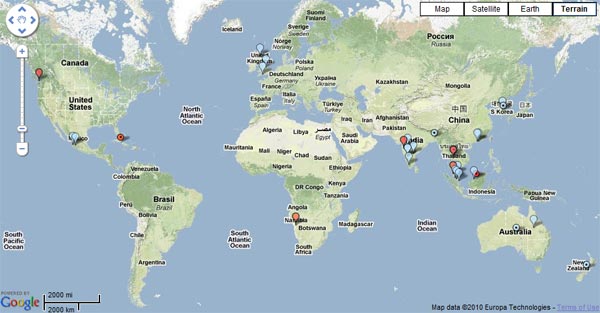Tracking H1N1 through the Internet
Next flu season, mining Internet sites such as Facebook, Twitter, and Google news may provide a faster way to track the spread of H1N1 than reports from official agencies like the World Health Organization (WHO) and the Centers for Disease Control and Prevention (CDC). That’s the idea behind a new generation of disease surveillance tools, including HealthMap, an interactive online system that trawls the Internet for news, both formal and informal, tracking a virus virtually in real-time.

During the global spread of pandemic influenza A (H1N1) last year, HealthMap was able to pick up one of the earliest reports of the disease, well before the outbreak was confirmed by government agencies. Researchers kept the system running throughout the 2009 flu season and found that, on average from country to country, there was a 12-day lag period between informal reports of suspected H1N1 cases and formal confirmations of the virus. After the last wave of H1N1 outbreaks ended, researchers analyzed their data and found that lag periods coincided with a country’s gross domestic product (GDP) - the wealthier the country, the faster the response. The results of their analysis are published in the current issue of The New England Journal of Medicine.
John Brownstein, assistant professor at Children’s Hospital Boston and co-founder of HealthMap, says last year’s H1N1 pandemic was an unprecedented opportunity to test the Internet as a dynamic resource for tracking a particularly fast-spreading disease. At the height of the pandemic, the Internet was flooded with minute-by-minute reports from informal sources like news outlets, blogs, and other websites, well before official agencies could confirm suspected cases. “H1N1 in general was maybe a wake-up call in terms of our capability of dealing with [an] influx of data in an emerging pandemic,” says Brownstein.
Today the WHO and the CDC are using HealthMap every day to help determine how to better track and handle a future H1N1outbreak. HealthMap also monitors the spread of 200 other diseases, such as dengue fever and foot-and-mouth disease. Brownstein’s team recently launched an iPhone application that personalizes HealthMap for a given user. The application uses global positioning to flag outbreaks in one’s area. Both the website and the iPhone app let users type in any flu cases they know of, or any symptoms they may be suffering–information Brownstein can also use to follow the disease.

Healthmap is one of a number of new programs springing up to track infectious disease, using unconventional sources like emergency-room admittance, over-the-counter prescription sales, and school absenteeism reports. In 2008, Google found that flu season in a given location correlated with certain keywords that users typed into its search engine. Google launched an application called Google Flu Trends, and published a paper in Nature, reporting that the system could detect an outbreak of influenza two weeks before the CDC issued a confirmation. The CDC method, which includes molecular testing to confirm specific viruses, is more accurate but also time- and resource-intensive.
Internet-based approaches may prove especially useful in tracking new pathogens. “New diseases can be the most devastating because the human body and the public health infrastructure are not set up to deal with it,” says Marc Levy, deputy director for the Center for International Earth Science Information Network at Columbia University. “That’s why this new technology is so important, because it dramatically simplifies the process of detecting new diseases in a geographically accurate way.”
Levy cautions that as new technologies like HealthMap become more common, they may suffer from a Big Brother bias–governments that hold a tight rein may choose to shut down access to news outlets or Internet sites, creating an information blackout. “There’s a danger that these powerful tools would be the target of restrictions,” says Levy. “But those are risks worth tolerating.”
To create HealthMap, Brownstein and his colleague Clark Freifeld, a research software developer at Children’s Hospital Informatics Program, devised algorithms to sift through various Internet sources and news aggregators like Google, looking for keywords in seven different languages, and gauging a source’s reliability. Verified reports are flagged to a corresponding location on an electronic map of the world, allowing users to watch a disease like H1N1 unfold by clicking through a timeline below the map. Users can also click on a flag, which links to a news report, hospital press release, or blog entry.
In the future, Brownstein and Freifeld plan to tap into the minute-by-minute world of social networking, and will monitor sites like Twitter and Facebook for even earlier signs of disease outbreaks. “We’re walking a fine line getting into these data sources,” says Brownstein. “Twitter is a very difficult source, with a very short amount of text that’s hard to verify. One individual case might not tell us something is happening, but if we’re having enough people reporting in a location, that might mean something. So we’ll wait for a threshold of reporting, instead of relying on just one tweet of, say, an Ebola outbreak.”
Keep Reading
Most Popular
Large language models can do jaw-dropping things. But nobody knows exactly why.
And that's a problem. Figuring it out is one of the biggest scientific puzzles of our time and a crucial step towards controlling more powerful future models.
The problem with plug-in hybrids? Their drivers.
Plug-in hybrids are often sold as a transition to EVs, but new data from Europe shows we’re still underestimating the emissions they produce.
Google DeepMind’s new generative model makes Super Mario–like games from scratch
Genie learns how to control games by watching hours and hours of video. It could help train next-gen robots too.
How scientists traced a mysterious covid case back to six toilets
When wastewater surveillance turns into a hunt for a single infected individual, the ethics get tricky.
Stay connected
Get the latest updates from
MIT Technology Review
Discover special offers, top stories, upcoming events, and more.